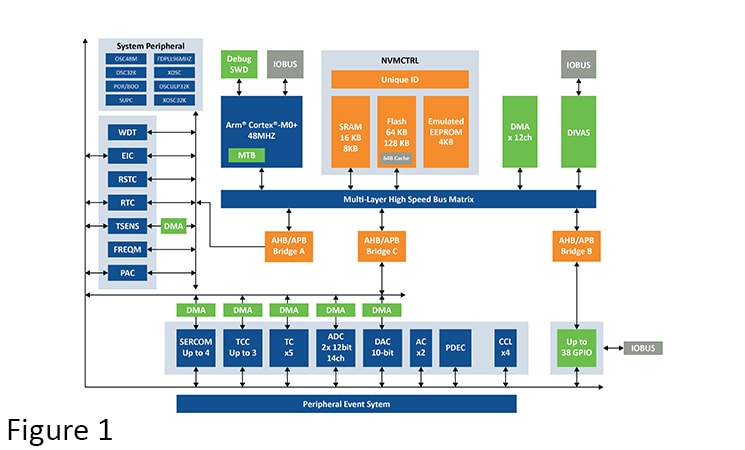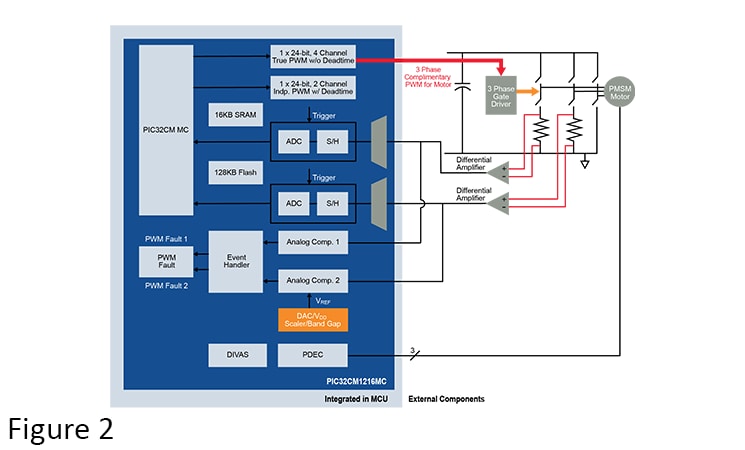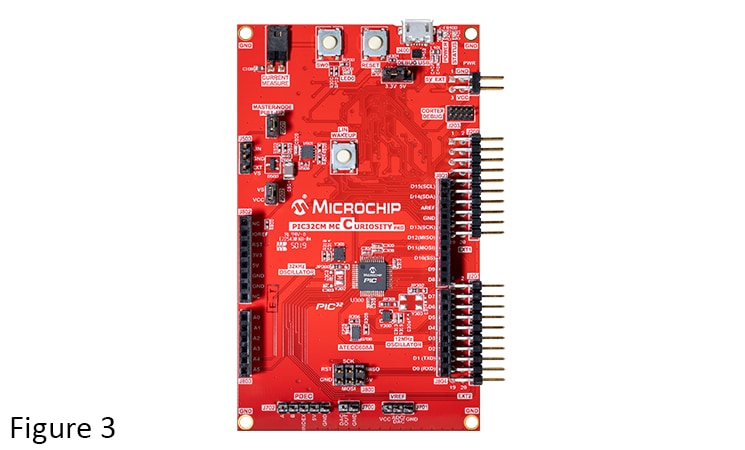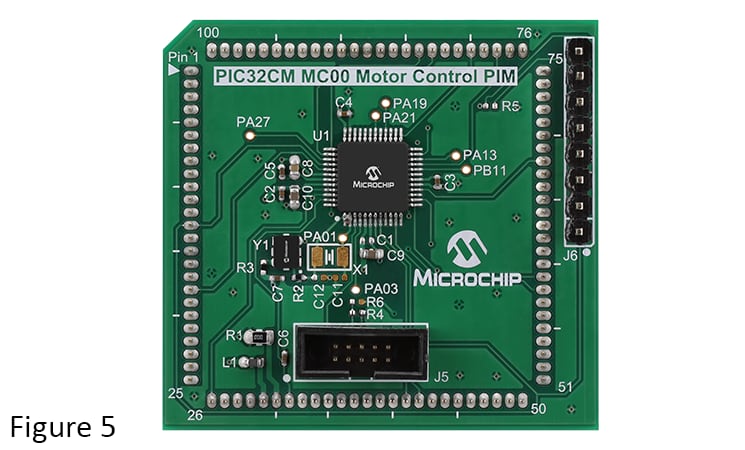The First PIC32C MCUs Combines Power of Arm® Cortex® Core with High-Performance Analog and Digital Peripherals
Combining the best features from PIC32M and SAM devices enhances performance for embedded industrial and motor control applications.
Microchip’s new PIC32C family of 32-bit microcontroller (MCU) series – PIC32CM MC – is based on Arm® Cortex®-M0+ core. PIC32C family offers an integrated and simplified approach that includes high-performance analog and digital peripherals which augments performance of Arm Cortex core for embedded control.
Microchip has been a leader in developing advanced peripherals which act as hardware accelerators with minimal CPU intervention. PIC32CM MC is equipped with such peripherals as multi-channel Direct Memory Access (DMA), flexible serial communication modules and high-speed comparators which greatly augment the overall computational performance of the MCU. Furthermore, high performance analog and mixed signal peripherals like Analog-to-Digital Converters (ADC) enable accurate measurement of real-world analog signals and high-resolution timers like Time/Counter for Control (TCC) allow precision timing for embedded control applications. These peripherals allow development of performance intensive embedded applications on a cost-effective Arm Cortex M0+ core.
For easy development, these devices are supported by Microchip’s MPLAB® development ecosystem, which includes MPLAB X Integrated Development Environment (IDE), the MPLAB XC32 Compiler and free-to-use MPLAB Harmony v3 embedded software development framework.
What is New with PIC32CM MC Family?
PIC32CM devices, with its 5V operation capability and Arm Cortex M0+ core, make it the ideal MCU for noisy and cost-competitive applications like home appliances, industrial control and other 5V applications. This 5V device family is a lower-cost extension of Microchip’s current SAM C2x portfolio of 32-bit MCUs.
PIC32CM MC MCUs balances a robust peripheral payload for low-cost, single-motor control in noisy environments. As these devices run directly on 5V, they reduce the number of voltage supplies required in an application, making them perfect for portable battery powered motor applications such as power tools, vacuum cleaners, small robotics, and toys.
Key Features
• CPU clock speed up to 48 MHz strikes a balance between performance and power consumption
• Up to 128 KB embedded Flash and 16 KB SRAM ideal for embedded control applications
• Operating voltage of 2.7V–5.5V ensures best possible signal-to-noise ratio and robustness in term of noise immunity, EMC, ESD and latch up
• Dual 12-bit simultaneous sampling Analog-to-Digital Converters (ADCs) for higher analog precision
• Position Decoder (PDEC): New to PIC32CM MC, PDEC provides robust, low latency and core independent measurement of rotor angular position, number of revolutions and speed for precision motor control applications
• Timer/Counter for Control (TCC) peripheral provides dedicated timers for industrial and motor control
• A 16-bit Sigma-Delta type ADC which can be used for V/I tracking, high-accuracy temperature sensing and general meteorology functions
• Flexible peripherals including four Serial Communication Modules (SERCOMs) that can be configured to act as an USART, UART, SPI, I2C, RS485 or LIN bus interface
• 12-channel Direct Memory Access (DMA) controller with Cyclical Redundancy Check (CRC) module enables multiple memory transfer paths without CPU intervention
• High-speed comparators ensure cycle-by-cycle overcurrent limiting for increased application safety and robustness
• Functional pin compatibility with current SAM C20 devices in 32- and 48-pin packages
Figure 1: PIC32CM MC Family Block Diagram

Optimized MCU Design for a 3-Phase Single Motor Drive
PIC32CM MC series is highly optimized to enable superior performance 3-phase motor control. It is equipped with a rich peripheral set which reduce the computational burden for the CPU and reduces the system cost by integrating requisite high performance mixed signal peripherals in the MCU. Its ability to operate at 5V enables robust operation in noisy environments often associated with motor control applications.
A simplified application block diagram is shown in Figure 2 (DAM ID – 273461) representing the major connections from the PIC32CM to the power stage for sensorless single motor drive with PIC32CM MC MCUs.
The following peripherals greatly enhances the value of the PIC32CM MC in motor control applications:
ADC – 12-bit 1 MSPS dual sample and hold ADCs allow simultaneous sampling of motor phase currents which enable precise reconstruction of back EMF signals for accurate rotor position estimation. Additionally, a Sigma-Delta type ADC is also available in the PIC32CM which can be used for V/I tracking, high accuracy temperature sensing and general metrology functions.
Comparators and DAC – High speed comparators ensure cycle-by-cycle over current limiting for increased application safety and robustness. On-chip DACs can be used to generate precise overcurrent comparator references thereby reducing the need for an external voltage reference.
TCC – 24-bit TCC channels with dead time Insertion provides improved resolution PWM channels which allows for safe and precise operation of motor inverter.
DIVAS – DIVide And Square root module allows for faster and CPU independent mathematical calculation (Divide, Square Root), essential in many control applications.
PDEC – PIC32CM MC devices feature a Position DECoder peripheral (PDEC / QEI) to interface directly to a 3-wire quadrature encoder with support for incremental encoders as well as optical encoders. Typical encoders have three output channels, two for phases (QEAx and QEBx) and an index pulse (INDXx) and provide details on the absolute rotor position, number of revolutions, speed and direction.
This gives designers the option for absolute rotor positioning with 16-bit resolution and can also be used in conjunction with a typical FOC based phase-current measurement for torque, speed and positioning control. Low- cost encoder technology has been a main-stay in motor control applications where precise determination of rotor position and rotational direction are important. It has become even more commonplace in personal electric applications such as e-bike and e-scooter.
Figure 2 - Sensorless Single-Motor Drive with PIC32CM MC 
Development Software and Hardware
To help you develop your designs with PIC32CM MC devices, Microchip provides a variety of development boards and ready to use demo examples supported in MPLAB Harmony v3.
Software Tools Support
PIC32C series devices are supported in the Microchip’s MPLAB X IDE with support in MPLAB Harmony v3, as well as in the IAR and KEIL toolchains.
Demo examples for sensored and sensorless control of permanent magnet synchronous motors are available within MPLAB Harmony v3 free of charge and features a Reduced-Order Luenberger Observer-type control loop.
Hardware Development Boards
For hardware development, prototyping and debugging, the PIC32CM series is supported by following development boards.
PIC32CM MC00 Curiosity Pro Evaluation Kit (EV15N46A) — See Figure 3
This evaluation kit provides the hardware platform to evaluate the PIC32CM MC MCU and it also supports Arduino style add-on boards.

PIC32CM MC00 Curiosity Nano Evaluation Kit (EV10N93A) — See Figure 4
A very low-cost Curiosity Nano Evaluation Kit is also available, which provides easy pin-level access to all the device functions. 
PIC32CM MC00 Motor Control Plug-In-Module (EV94F66A) — See Figure 5
For BLDC motor control applications, Microchip offers a Plug-In-Module (PIM) EV94F66A, for use on the MCLV-2 and MCHV-3 motor control development boards.

Conclusion
The new PIC32C devices merges the best features of SAM and PIC32M devices. These are supported by comprehensive development ecosystem, design resources and solutions to streamline your development.
Learn more about Microchip’s PIC32C and PIC32CM device family for your next 5V motor control and industrial design.
